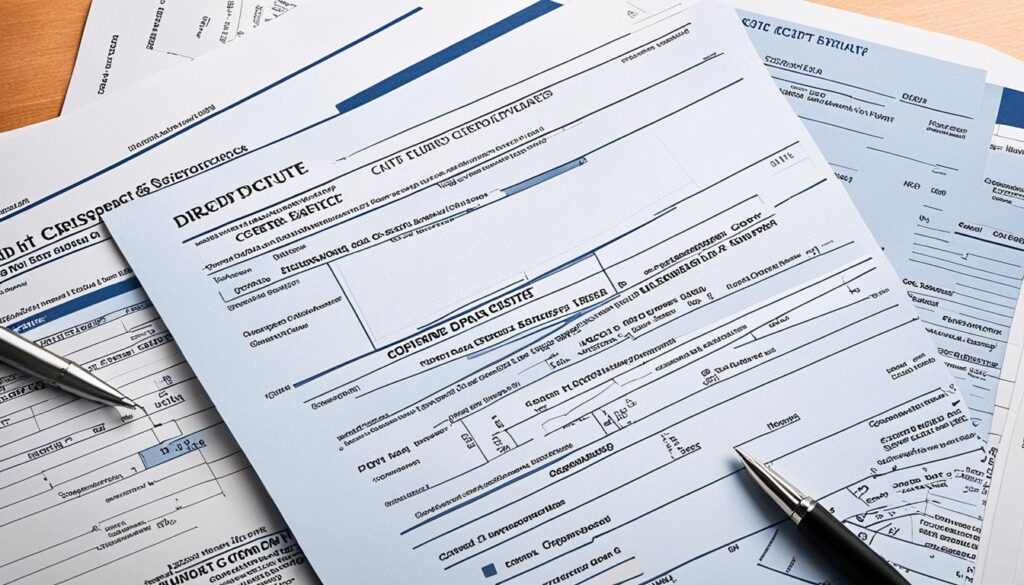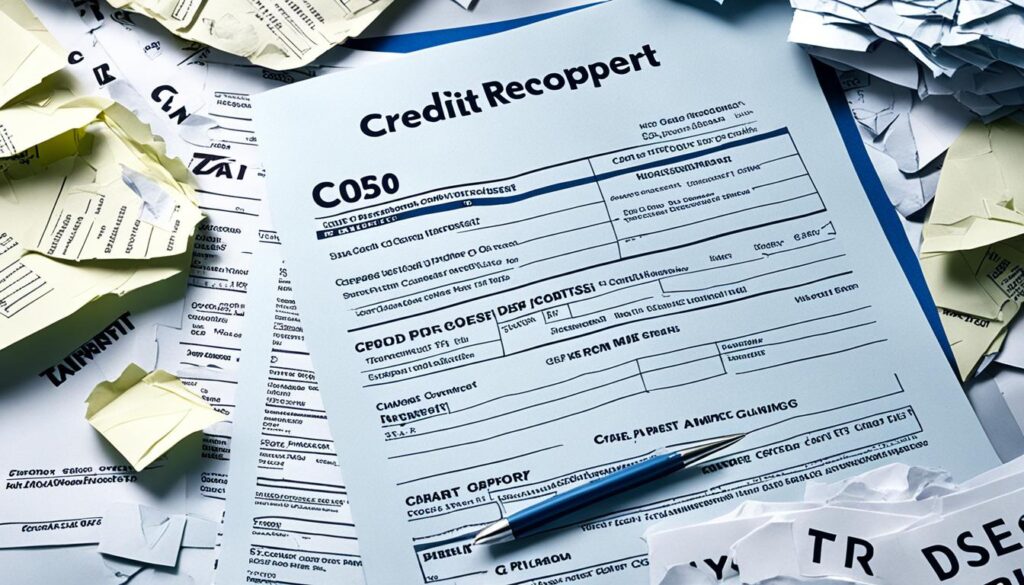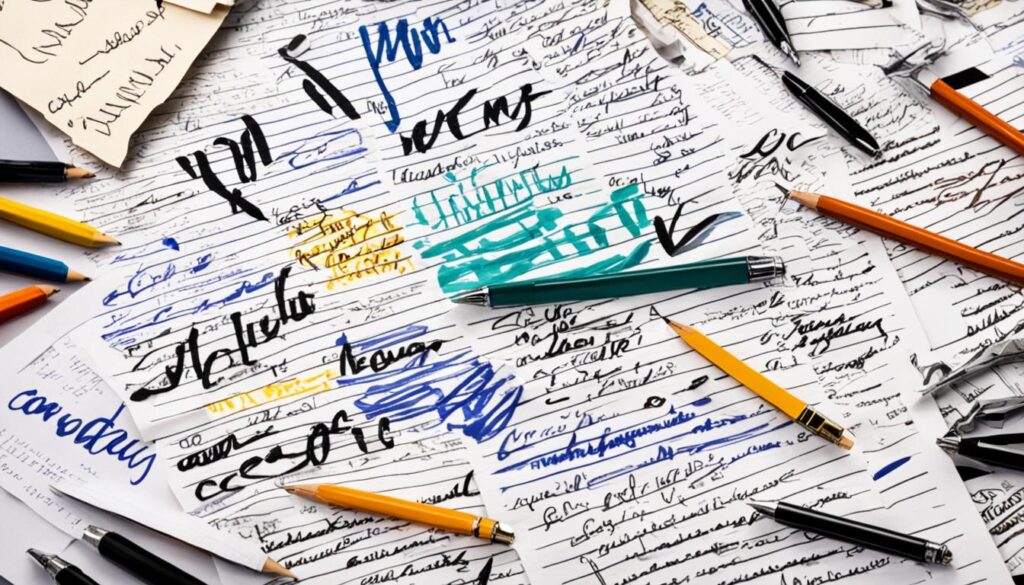Maintaining a healthy credit report is crucial for achieving financial stability and accessing favorable lending opportunities. However, inaccuracies or errors on one’s credit report can become a significant obstacle, negatively impacting credit scores and financial well-being. Fortunately, consumers have the power to dispute these discrepancies and take action to correct their credit files. This article will provide a comprehensive guide on how to craft effective sample dispute letters to credit bureaus, empowering individuals to regain control of their credit histories.
Key Takeaways
- Learn to identify and address inaccuracies on your credit report
- Understand the importance of disputing credit report errors
- Discover the essential elements of a compelling dispute letter
- Gain insights into the credit dispute process and your consumer rights
- Explore sample dispute letters to help you take action and improve your credit standing
Understanding Credit Dispute Letters
A credit dispute letter is a powerful tool in the hands of consumers who want to correct inaccuracies on their credit report. This letter is a formal request sent to credit reporting agencies, such as Equifax, Experian, and TransUnion, to investigate and remove any false or misleading information that may be negatively impacting one’s credit score.
What is a Credit Dispute Letter?
A credit dispute letter is a written communication that outlines the specific errors or inaccuracies found on a consumer’s credit report. The goal of this letter is to prompt the credit bureaus to investigate the disputed items and make the necessary corrections to ensure the accuracy of the consumer’s credit report.
Importance of Disputing Credit Report Inaccuracies
Maintaining the accuracy of one’s credit report is crucial, as inaccuracies can significantly impact a person’s credit score and their ability to access credit, loans, or even secure employment. By taking the time to dispute credit report errors, consumers can ensure that their credit score accurately reflects their creditworthiness, ultimately leading to better financial opportunities and improved financial well-being.
“Disputing inaccuracies on your credit report is a crucial step in maintaining a healthy financial profile and improving your credit score.”
The process of correcting credit report errors is free and will not harm one’s credit score. In fact, addressing these inaccuracies can have a positive impact on a person’s credit score in the long run.
Gathering Supporting Documents
When disputing inaccuracies on your credit report, it’s crucial to gather supporting documentation that can substantiate your claims. This evidence can significantly strengthen your credit dispute letter and increase the likelihood of a successful outcome.
Types of Evidence to Include
The types of documentation you should gather to support your credit dispute may include:
- Copies of payment records, such as bank statements, canceled checks, or credit card statements demonstrating timely payments
- Account statements or other records that contradict the information reported on your credit report
- Correspondence with the creditor, such as letters or emails, that prove the inaccuracy of the reported information
- Identification documents, such as a driver’s license or birth certificate, to verify your personal information
- Receipts, invoices, or other documents that provide evidence of the correct information
By gathering this credit dispute documentation, you can build a strong case and increase the chances of successfully disputing credit report inaccuracies. The supporting evidence for credit disputes will demonstrate the validity of your claims and prompt the credit bureaus to investigate and correct the types of documents for credit report disputes.
| Document Type | Purpose |
|---|---|
| Payment Records | Prove timely payments and contradict negative information on credit report |
| Account Statements | Provide evidence that contradicts the reported information |
| Correspondence with Creditors | Demonstrate communication and proof of inaccuracies |
| Identification Documents | Verify personal information and identity |
| Receipts and Invoices | Offer additional evidence of correct information |

“Gathering the right supporting evidence for credit disputes is crucial for successfully challenging inaccuracies on your credit report.”
Drafting an Effective Dispute Letter
Crafting a well-structured credit dispute letter is crucial for effectively challenging inaccuracies on your credit report. To create a compelling letter, you’ll need to include several key elements. First and foremost, clearly identify the specific items you are disputing, providing a detailed explanation of why the information is incorrect. Additionally, it’s important to request that the credit reporting agency investigate the matter and correct any errors found.
Key Elements of a Compelling Letter
When writing a credit dispute letter, be sure to incorporate the following essential components:
- Specific identification of the disputed items on your credit report
- Detailed explanation of why the information is inaccurate or incomplete
- Request for the credit reporting agency to investigate the dispute and correct any errors
- Copies of any supporting documentation to substantiate your claims
- Delivery of the letter via certified mail with a return receipt to ensure proper documentation
By following these best practices, you can increase the chances of a successful credit dispute and have any erroneous information removed from your credit report. Effective credit dispute letter templates can serve as a valuable guide in crafting your own personalized letter to address how to write a credit dispute letter and the essential components of a credit dispute letter.

“A well-written and comprehensive credit dispute letter is the foundation for resolving inaccuracies on your credit report.”
sample dispute letters for credit bureau
When it comes to disputing inaccuracies on your credit report, having access to sample credit dispute letters can be a valuable resource. These templates often serve as a starting point for crafting your own personalized letter, ensuring that you cover all the necessary components while effectively articulating your case.
Many websites offer a range of printable credit dispute letter templates that you can use as a guide. These templates typically include key elements such as your personal information, a detailed description of the disputed items, and a clear request for the credit reporting agency to investigate and correct the inaccuracies.
By utilizing these credit dispute letter examples, you can streamline the process of drafting your own letter while ensuring that your points are effectively communicated. This can save you time and help ensure that your dispute is presented in a professional and compelling manner.

Remember, while these templates can serve as a valuable starting point, it’s important to tailor the letter to your specific situation and ensure that it accurately reflects the details of your dispute. This personalized approach can increase the likelihood of a successful outcome.
Addressing Specific Credit Report Errors
Credit reports can sometimes contain a variety of errors, from false account status information to wrong account numbers and inaccurate credit limits or balances. By carefully reviewing one’s credit report and identifying these specific issues, consumers can craft targeted credit dispute letters to address the inaccuracies and have them corrected with the credit bureaus.
One common credit report error is the presence of an ex-spouse on an account. This can happen when a joint account is not properly closed or updated after a divorce. In such cases, the affected individual should dispute this information with the credit bureaus, providing documentation to prove the account is no longer theirs.
Another frequent issue is signs of identity theft, such as accounts or inquiries that the consumer did not authorize. Promptly disputing these fraudulent entries is crucial to prevent further damage to one’s credit profile.
| Common Credit Report Errors | Recommended Action |
|---|---|
| False account status information | Dispute the inaccurate information with the credit bureaus |
| Wrong account numbers | Provide the correct account information and request the error be corrected |
| Inaccurate credit limits or balances | Submit documentation to verify the correct credit limit or balance |
| Presence of an ex-spouse on an account | Provide proof that the account is no longer yours and request it be removed |
| Signs of identity theft | Dispute the fraudulent entries and take steps to protect your identity |
By addressing these specific credit report errors through the credit dispute process, consumers can take proactive steps to fix mistakes on credit reports and improve their overall credit standing.
Submitting Your Dispute Letter
When mailing a credit dispute letter, it’s crucial to follow specific instructions and best practices to ensure your letter is received and processed effectively. The steps you take when submitting a credit dispute letter can make all the difference in getting the resolution you deserve.
Mailing Instructions and Best Practices
To submit a credit dispute letter properly, consider these tips:
- Send your letter via certified mail with a return receipt. This provides proof of delivery and a timeline for the credit bureau’s response.
- Make copies of your dispute letter and any supporting documentation before mailing. This creates a paper trail in case you need to reference the materials later.
- Keep track of the date you submitted your dispute and any responses you receive from the credit reporting agency. Monitoring the process is key to ensuring a timely and satisfactory resolution.
By following these credit dispute letter submission tips, you can strengthen your case and increase the chances of a successful outcome. Taking the time to properly submit a credit dispute letter can pay off in the long run.

“Submitting a credit dispute letter correctly is the first step in getting inaccuracies removed from your report.”
Following Up on Your Dispute
After submitting a credit dispute letter, it’s crucial to actively monitor the credit dispute resolution process and follow up on the status of your credit report disputes. This proactive approach can help ensure a successful resolution to any inaccuracies found on your credit report.
The credit dispute timeline can vary, but credit bureaus are typically required to investigate and respond within 30 days. By staying engaged throughout the process, you can provide any additional information or documentation that may be requested and review the final outcome to confirm the errors have been corrected.
- Contact the credit reporting agency to check on the progress of the dispute investigation.
- Provide any supplementary information or documentation the agency may require.
- Review the final results to ensure the inaccuracies have been successfully removed from your credit report.
Maintaining regular follow-up on credit report disputes and monitoring the credit dispute resolution can help you achieve a successful outcome and improve the accuracy of your credit information.
| Step | Action | Timeline |
|---|---|---|
| 1. Initiate Dispute | Submit dispute letter to credit bureaus | As soon as possible |
| 2. Credit Bureau Investigation | Credit bureaus investigate the dispute | Within 30 days |
| 3. Follow-up | Contact credit bureaus to check status and provide additional information | Ongoing, as needed |
| 4. Dispute Resolution | Credit bureaus provide final determination on the dispute | Within 30 days of investigation |
By staying diligent and persistent in monitoring credit dispute resolution and following up on credit report disputes, you can ensure a timely and successful outcome for your credit report corrections.
Rights and Protections Under the FCRA
The Fair Credit Reporting Act (FCRA) serves as a crucial safeguard for consumers, providing them with vital rights and protections when it comes to their credit reports. Under the FCRA, individuals have the right to dispute any inaccuracies found on their credit reports, and credit reporting agencies are legally obligated to investigate and correct any errors discovered.
The FCRA also outlines specific timelines and procedures that credit bureaus must adhere to when processing these disputes. This empowers consumers to navigate the credit dispute process effectively, ensuring the accuracy and integrity of their credit information. By understanding their rights under the FCRA, individuals can take a proactive stance in maintaining the reliability of their credit reports and protecting their financial well-being.
Ultimately, the FCRA serves as a vital framework that safeguards consumer credit rights and holds credit reporting agencies accountable. Armed with this knowledge, consumers can confidently exercise their rights and work towards achieving a accurate and fair credit profile, which is essential for making informed financial decisions and maintaining financial stability.
FAQ
What is a credit dispute letter?
Why is it important to dispute inaccuracies on my credit report?
What types of evidence should I include in my credit dispute letter?
What are the key elements of an effective credit dispute letter?
Where can I find sample credit dispute letters?
What are some common types of credit report errors?
How should I submit my credit dispute letter?
What should I do after submitting my credit dispute letter?
What rights and protections do I have under the Fair Credit Reporting Act (FCRA)?
Source Links
- Ultimate Guide to Printable Dispute Letter Templates-2024 | WPS Office Blog – https://www.wps.com/blog/ultimate-guide-to-printable-dispute-letter-templates/
- CFPB Sample Letter To Your Bank or Credit Union To Dispute Information It Provided About Your Checking Account History | PDF | Identity Theft | Transaction Account – https://www.scribd.com/document/538707304/201602-Cfpb-Sample-Letter-to-Your-Bank-or-Credit-Union-to-Dispute-Information-It-Provided-About-Your-Checking-Account-History-2
- Sample Letter Disputing Errors on Credit Reports to the Business that Supplied the Information – https://consumer.ftc.gov/articles/sample-letter-disputing-errors-credit-reports-business-supplied-information
letter dispute credit report, sample letter to remove items from credit report, sample dispute letter to credit bureau, FCRA dispute timeline, credit bureau dispute letter template, credit repair letters to credit bureaus, dispute credit report sample letter, personal information update letter credit bureau template, credit report dispute letters, dispute letter for credit report, dispute letter template for credit bureaus, sample credit report dispute letter, writing a dispute letter

